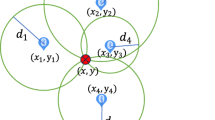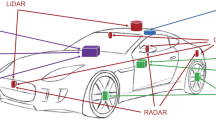Abstract
According to rapid extension of wireless sensor network localization, indoor localization using fingerprint has turned out to be more considerable lately. It contains of a database called Receive Strength Signal Indicator vectors, which is a primitive amount in wireless sensor network fingerprinting positioning. The equivalence of a few strategies is brought up from the literary works, and some new variants are presented in this study. A combination of a clustering strategy named affinity propagation and statistical and probabilistic positioning procedures is considered in this review and at the same time, the impact of some components in our methodology onto positioning precision will be investigated. Affinity propagation clustering method set up a common baseline for assessing the relative accuracy of various indoor location methods effectively. Eventually two coarse localization methods as Mahalanobis norm method and similarity to exemplar receive strength signal vector are compared based on positioning accuracy and performance. Experimental outcomes prove that the intended algorithm will advance the accuracy and localization error compared with the method without clustering.








Similar content being viewed by others
References
Dawes, B., & Chin, K. W. (2011). A comparison of deterministic and probabilistic methods for indoor localization. Journal of Systems and Software, 84(3), 442–451.
Lymberopoulos, D., Liu, J., Yang, X., Choudhury, R. R., Handziski, V., & Sen, S. (2015). A realistic evaluation and comparison of indoor location technologies: Experiences and lessons learned. In Proceedings of the 14th international conference on information processing in sensor networks (pp. 178–189). ACM.
Zekavat, R., & Buehrer, R. M. (2011). Handbook of position location: Theory, practice and advances (Vol. 27, pp. 359–522). New York: Wiley.
Moghtadaiee, V., & Dempster, A. G. (2012). WiFi fingerprinting signal strength error modeling for short distances. In 2012 International conference on indoor positioning and indoor navigation (IPIN) (pp. 1–6). IEEE.
Feng, C., Au, W. S. A., Valaee, S., & Tan, Z. (2012). Received-signal-strength-based indoor positioning using compressive sensing. IEEE Transactions on Mobile Computing, 11(12), 1983–1993.
Jain, V. K., Tapaswi, S., & Shukla, A. (2013). Performance analysis of received signal strength fingerprinting based distributed location estimation system for indoor wlan. Wireless Personal Communications, 70(1), 113–127.
Bahl, P., Padmanabhan, V. N., & Balachandran, A. (2000). Enhancements to the RADAR user location and tracking system. Technical report, Microsoft Research.
Khodayari, S., Maleki, M., & Hamedi, E. (2010). A RSS-based fingerprinting method for positioning based on historical data. In 2010 International symposium on performance evaluation of computer and telecommunication systems (SPECTS) (pp. 306–310). IEEE.
Kushki, A., Plataniotis, K. N., & Venetsanopoulos, A. N. (2007). Kernel-based positioning in wireless local area networks. IEEE Transactions on Mobile Computing, 6(6), 689–705.
Nazir, U., Arshad, M. A., Shahid, N., et al. (2012). Classification of localization algorithms for wireless sensor network: A survey. In 2012 international conference on open source systems and technologies (ICOSST) (pp. 1–5). IEEE.
Tian, Z., Tang, X., Zhou, M., & Tan, Z. (2014). Probability distribution-aided indoor positioning algorithm based on affinity propagation clustering. In The Proceedings of the second international conference on communications, signal processing, and systems (pp. 911–919). Springer International Publishing.
Boukerche, A., Oliveira, H. A., Nakamura, E. F., & Loureiro, A. A. (2007). Localization systems for wireless sensor networks. IEEE Wireless Communications, 14(6), 6–12.
Bachrach, J., & Taylor, C. (2005). Localization in sensor networks. Handbook of sensor networks: Algorithms and architectures, 1, 277–310.
Honkavirta, V., Perala, T., Ali-Loytty, S., & Piche, R. (2009). A comparative survey of WLAN location fingerprinting methods. In 6th Workshop on positioning, navigation and communication, 2009 (WPNC 2009) (pp. 243–251). IEEE.
Zhou, M., Wong, A. K. S., Tian, Z., Zhang, V. Y., et al. (2013). Adaptive mobility mapping for people tracking using unlabelled Wi-Fi shotgun reads. IEEE Communications Letters, 17(1), 87–90.
Lee, C. W., Lin, T. N., Fang, S. H., & Chou, Y. C. (2013, September). A novel clustering-based approach of indoor location fingerprinting. In 2013 IEEE 24th international symposium on personal indoor and mobile radio communications (PIMRC) (pp. 3191–3196). IEEE.
Frey, B. J., & Dueck, D. (2007). Clustering by passing messages between data points. Science, 315(5814), 972–976.
De Maesschalck, R., Jouan-Rimbaud, D., & Massart, D. L. (2000). The Mahalanobis distance. Chemometrics and Intelligent Laboratory Systems, 50, 1–18.
Karegar, P. A. (2015). A new approach in wireless sensor network fingerprinting localization by affinity propagation and K-nearest neighbor method. International Journal of Scientific Engineering and Technology, 4(5), 335–337.
Hilbe, J. M., Robinson, A. P. (2013). Methods of statistical model estimation. Boca Raton: Chapman and Hall.
Author information
Authors and Affiliations
Corresponding author
Rights and permissions
About this article
Cite this article
Karegar, P.A. Wireless fingerprinting indoor positioning using affinity propagation clustering methods. Wireless Netw 24, 2825–2833 (2018). https://doi.org/10.1007/s11276-017-1507-0
Published:
Issue Date:
DOI: https://doi.org/10.1007/s11276-017-1507-0




